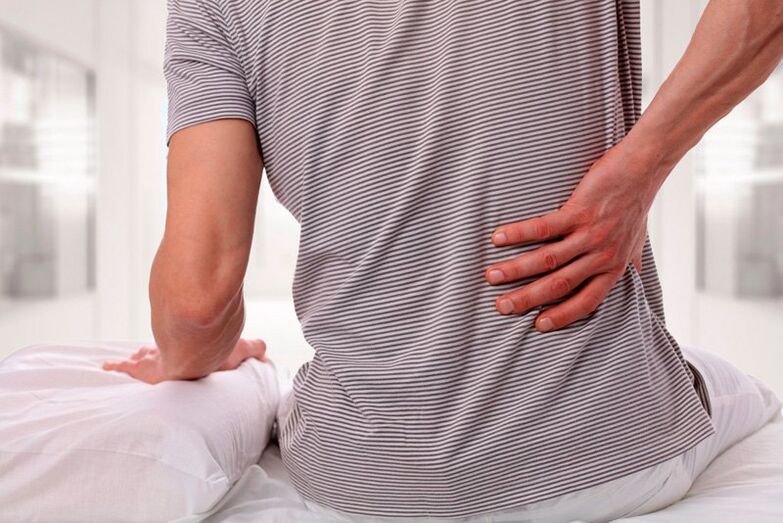Back pain (synonymous with back pain) is one of the most common reasons to see a doctor - second to acute respiratory illnesses1. Usually, such complaints go to a neurologist, therapist or general practitioner. According to international studies, between 19 and 43% of the adult population recently surveyed reported back pain in the last month, from 27 to 65% - in the last year. Those who have experienced this at least once in their life, have 59-84% 1. Almost every fifth adult inhabitant of our planet can experience severe back pain at this time. Their most common localization is the lower back and lower back.

Why does back pain happen?
Among the main reasons for the development of back pain are:
- Vertebral causes - related to pathologies of the spine:
- pathology of the disc, including herniation;
- spinal stenosis;
- arthropathy;
- consequences of trauma;
- birth defects and developmental defects;
- metabolic disorder;
- spondylitis - inflammatory processes in the disc joints.
- Hypoallergenic - not associated with pathologies of the spine:
- ligament and muscle sprains associated with heavy loads;
- myofascial syndrome - chronic muscle pain;
- myositis - inflammation of the muscle;
- diseases of internal organs;
- pathology of the great vessels, for example, aneurysm (strong dilation) of the abdominal aorta;
- hip arthritis - an inflammatory-dystrophic disease;
- mental disorder, etc. v.
Depending on the origin, the following types of pain are distinguished:
- Private- is associated with a specific disease that can be detected by standard examination methods. This type accounts for up to 3% 1 in all cases. These can be fractures due to spinal compression, tumors, infectious processes, diseases of the pelvic organs (especially back pain in women).
At the same time, there are certain symptoms, called "red flags", that indicate serious diseases and require intensive examination. Including:
- Unreasonably rapid loss of body weight and/or signs of a history of cancer (tumour);
- weakness in the lower extremities, impaired sensitivity and function of the pelvic organs (cauda equina syndrome);
- the use of antibiotic therapy, an increase in body temperature (infectious processes);
- trauma or previous diagnosis of osteoporosis, age over 55 (spinal fracture);
- youth - up to 20 years;
- long-term preservation of painful sensations and their intensity, despite treatment;
- associated with general weakness or with gait disturbance, aggravated at night, unchanged with change in body position.
- Lens form- next in frequency (up to 27%). It develops due to compression and/or inflammation of the spinal roots, which exit through the openings of the spine. This type can be indicated by pain that increases with coughing, sneezing, physical exertion, and other types of activity.
- No specific- often more acute, it is difficult to immediately determine the specific cause of its development, it is often the result of dystrophic changes in the bones, cartilage tissue of the spine, as well as the muscles and ligaments that make up the spine. so the supporting apparatus of the rear. In the International Classification of Diseases (ICD-10), there is a special section devoted to the definition of such syndromes - back pathology.
Such back pain accounts for up to 85% of 1 of all cases and is mainly associated with disruption of the normal functioning of individual structures of the spine, any of which can bebecome a source of pain impulses. The pain can be caused by compression (from compression of the nerve root) and reflex - from all other tissues, including the spasmodic muscle.
Another type of pain syndrome is described, which is not associated with any organic damage of the spine and disc tissues. This is called dysfunctional pain. It can be caused by psychological problems and chronic stress.
Differential localization:
| Name of . . . what | Where does it hurt |
| cervical pain | pain in the neck |
| cervicocranilagia | neck + head |
| neck pain | neck and give the hand |
| chest pain | back and chest pain, pain below the shoulder blades from the back |
| paralysis | lower back and highlights vùng |
| sciatica body pain | lower back + legs |
| sacral pain | sacrum |
| coccygodynia | coccyx |
In addition to the reasons, it is possible to identify factors that can provoke the development of pain syndrome:
- severe physical overload, which leads to excessive muscle and ligament strain;
- uncomfortable or static posture that a person takes for a long time;
- untrained muscles and their overload, inactivity;
- minor trauma and trauma;
- Hypothermia;
- prolonged immobility, such as bed rest;
- alcohol abuse;
- diseases of internal organs;
- joint pathology;
- overweight;
- individual characteristics: curvature of the spine, stooping;
- poor nutrition, diseases of the digestive system, which may be accompanied by impaired absorption of vitamins, mineral metabolism, eating a lot of salt affects joints;
- Occupational hazards: thermal effects, temperature fluctuations, vibrations, working with weights, etc. v.
The mechanism of development of low back pain is associated with an intervertebral disc mass, which can be caused by loads, both static and dynamic, trauma, and non-physiological posture. As a result, in one place the muscles contract and become overactive, and in another, they become overactive. All this leads to the development of myalgia, a change in pain sensitivity and the formation of pathological pain pulses.
In addition, muscle spasms can be a reflex response to pathology of the spine or diseases of internal organs. In this case, it is seen as a defensive response, but at the same time, it starts a new round of pain. In addition, with prolonged sustained contraction, the transmission of nerve impulses to the muscle fibers is disrupted, they become more excitable, calcium deficiency and circulatory disorders can occur. aggravate the situation.
Over time back pain, there may be:
- acute - lasts up to 6 weeks;
- subacute - from 6 to 12 weeks;
- chronic - last 12 weeks or so.
The symptoms
Symptoms of back pain depend on the cause, mechanism of development, and comorbidities.
For nonspecific pain, the following are characteristic:
- aching or painful pulling, sometimes tightening;
- increases with load or movement of the spine, as well as in certain positions, may decrease with kneading or rubbing muscles, as well as after resting in a comfortable position;
- may have side or back pain;
- When probing, pressing firmly, the change in contour and tension can be determined but there is no disturbance of sensitivity in the painful area, muscle strength is reduced, reflexes are not changed.
When a nerve root is compressed (radiculopathy), pain varies in intensity, can be shooting, often radiates down the leg and extremities may be stronger in the back. On examination, symptoms of damage to a specific nerve root are observed - muscle weakness, decreased sensitivity in a certain area.
Diagnose
The diagnostic algorithm for acute and chronic back disease is somewhat different.
Sting
To determine the treatment strategy, if possible, the physician must determine the cause of the pain syndrome: pinched nerves or their roots, trauma, tumor, inflammation, infection, osteoporosis, diseases of internal organs, etc. v. As a rule, these types of pain have quite vivid and specific clinical manifestations. After examination and palpation, the patient is referred to appropriate specialists or for further examination, eg:
- X-ray exam;
- MRI and CT of the spine;
- scintigraphy - a method of visualization using contrast medium;
- densitometry - determination of bone density;
- lab tests for tumor markers, rheumatology tests, biochemical blood tests, etc. v.
Patients with nonspecific acute pain usually do not require further study.
Chronic pain
Since the mechanism of its development has not yet been fully studied, its origin may be difficult, especially if it is a dysfunctional species that reflects pathology of other organs. It can be a manifestation of diseases such as irritable bowel syndrome, chronic cystitis, chronic pyelonephritis and others. In all cases, a thorough interview and examination of the patient is performed to decide on further treatment tactics.
For pain syndromes occurring against the background of dystrophic changes in the joints, after any mechanical stress or under the influence of other factors, magnetic resonance imaging can be used for dynamic monitoring. posture of the spine.
How to deal with acute back pain
Physicians who adhere to the principles of evidence-based medicine use the following tactics to manage patients with acute low back pain:
- inform the patient about the causes of the pain syndrome;
- excludes bed rest and recommends maintaining your usual activity;
- prescription drug and non-drug treatment;
- Monitor movement and adjust therapy.
When choosing a drug, attention should be paid to its analgesic effect, speed of action, and safety. First of all, non-specific anti-inflammatory drugs (NSAIDs) are prescribed, because of their proven effectiveness for back pain. One such drug is naproxen.
Naproxen is available as an oral tablet and a gel for external use. The drug is indicated as an analgesic for back pain related to trauma, overload, inflammation. It also has anti-inflammatory and antipyretic effects, the duration of which can last up to 12 hours. If you do not have the opportunity to see your doctor soon and the pain is causing significant discomfort, then you can take naproxen as follows: 2 tablets as the starting dose and then 2 tablets every 12 hours or 1 tablet every 8 hours. The period of admission without consulting a doctor is not more than 5 days.
While maintaining pain intensity, other classes of analgesics and sedatives (sedatives) may be prescribed.
Non-drug treatments include:
- warming;
- manual therapy;
- physical therapy;
- Massage;
- physical therapy;
- acupuncture and other alternative methods.
Chronic back pain treatment
If it is possible to determine the location of the pain and the source of the impulses, then local therapy will be used - blockade, visceral involvement and other procedures. For the remaining patients who do not apply such treatments for low back pain and low back pain, a different treatment regimen should be applied. Its primary goals are to reduce pain intensity and preserve quality of life.
In addition, for acute pain, drugs of the NSAID class are prescribed, including naproxen, other analgesics, muscle relaxants, and vitamin B3. Antidepressants are recommended when needed. Manual therapy should be performed by a qualified therapist, the indicated exercise therapy. Psychotherapy and physical therapy methods are used.
Preventive
To prevent back pain, it is essential to identify all possible risk factors and work to eliminate them.
For all types of pain, the following will help:
- adequate physical activity and muscle strengthening, including back;
- timely treatment of chronic diseases of internal organs;
- maintain physiological posture during work;
- quit smoking and alcohol;
- regular medical examination;
- adequate treatment and prevention of infections;
- balancing diet;
- wear comfortable shoes and clothes;
- properly organize work and life to protect the rear;
- Prevention of stress and emotional overload.

Comprehensive treatment and comprehensive rehabilitation of patients with back pain allows you to maintain quality of life, reduce disability and prevent the transition to a chronic form of the disease.


































